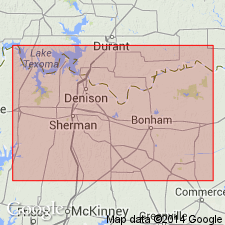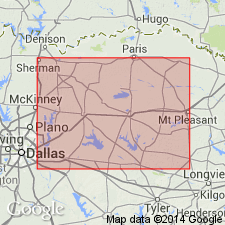
- Usage in publication:
-
- Lake Crockett sand member
- Modifications:
-
- Named
- Dominant lithology:
-
- Sand
- AAPG geologic province:
-
- South Oklahoma folded belt
- East Texas basin
- Ouachita folded belt
Summary:
Named as lower member of Lake Crockett formation of the Eagle Ford group for exposures in the ravine below the spillway of Lake Crockett, Fannin Co., TX in the Ouachita tectonic belt province. Measured section described below spillway. Occurs in outcrop near Sherman, Grayson Co., TX in the South Oklahoma folded belt province and in the subsurface in the East Texas basin. Formerly called the Fish Bed conglomerate (Taff, 1893) near the top of the Eagle Ford group in Grayson and Fannin Cos., TX; the Blossom sand member of the Eagle Ford formation at Sherman, TX (Gordon, 1911); and the sub-Clarksville formation in the subsurface of the East Texas basin (Herald, 1951). Consists of gray, fine-grained, friable sandstone, weathering yellowish brown to maroon with hematite; at least 5 ft thick, overlain by 0.5 ft of gray to reddish-brown, sandy, phosphatic conglomerate that weathers light gray, containing chert pebbles, petrified wood, and rare molluscan and fish remains. Lower contact transitional with shale of the Eagle Ford group. Underlies the Lake Crockett shale member [Late Cretaceous].
Source: GNU records (USGS DDS-6; Denver GNULEX).

- Usage in publication:
-
- Lake Crockett sand member†
- Modifications:
-
- Abandoned
Summary:
Abandoned because of homonymous nomenclature unsuitable for the rock-stratigraphic character of the units as they occur in the Ouachita tectonic belt and South Oklahoma folded belt provinces. Is replaced by Bells Sandstone Member of the Eagle Ford Formation. Assigned a late Turonian age.
Source: GNU records (USGS DDS-6; Denver GNULEX).
For more information, please contact Nancy Stamm, Geologic Names Committee Secretary.
Asterisk (*) indicates published by U.S. Geological Survey authors.
"No current usage" (†) implies that a name has been abandoned or has fallen into disuse. Former usage and, if known, replacement name given in parentheses ( ).
Slash (/) indicates name conflicts with nomenclatural guidelines (CSN, 1933; ACSN, 1961, 1970; NACSN, 1983, 2005, 2021). May be explained within brackets ([ ]).

